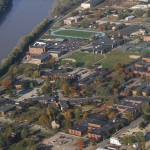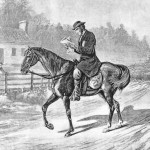The Hoosier State plays a special role in relation to the American population as a whole. According to the 2000 Census, the median center of US population falls in northeastern Daviess County.
The median center is a point calculated at the intersection of two imaginary axes dividing the number of people in the country in half—north and south, and east and west. The distinction is a major selling point for manufacturing in southwestern Indiana, for whom accessibility to distribution sites and population centers is of critical concern.
But there’s another way of calculating the distribution of people in the US, which also points to Indiana. From 1890 through 1940, the mean center of population fell within the state’s borders. The mean center has been described as an imaginary point at which a flat, rigid map of the US would balance if each US citizen were of identical weight.
In this way, the mean center of population can be understood as the country’s center of gravity.
First calculated in 1790 at a point near the Chesapeake Bay in Maryland, the mean center of population shifted 505 miles westward over the course of the ensuing century.
The 1890 census establishing the mean center in Decatur County just south of Greensburg was met with great fanfare, regionally. The Chicago Herald had a limestone monument erected marking the center spot. On May 10, 1891, an estimated ten thousand people gathered in an orchard on the property of Jacob Engel for the monument’s dedication ceremony.
Over the course of the next fifty years, the mean center of population remained within Indiana, inching gradually south-westward from Decatur County, to Bartholomew, Monroe, Owen, Greene and finally Sullivan County with each decennial census.
The slower pace of westward expansion after 1890 suggests that country’s frontier era had drawn to a close.






















